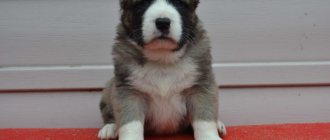A muzzle is necessary for a dog of any breed, and not just representatives of aggressive and large breeds, as many owners believe. This is a guarantee of the safety of people around, as well as a means of protection for overly curious pets, which will prevent them from picking up harmful or dangerous things from the ground. True, from the animal’s point of view, it is an incomprehensible object that causes discomfort and limits freedom, so not all dogs treat it kindly. How to accustom a dog to a muzzle so that your four-legged friend calmly reacts to being in this accessory?
How to train a dog to wear a muzzle with the least amount of effort?
Types of muzzles
Plastic
The model is made of plastic intertwined rods. The product is lightweight and quite durable.
After a walk, the plastic can be easily washed off from dirt. Due to the wide rods and the space free from the mouth (if the size is chosen correctly), the dog can easily open its mouth, which is very important for cooling the body in case of overheating.
The model will prevent the animal from trying to pick up something from the ground.
You should be careful when using a plastic product in winter, when exposed to frost: the material may crack.
The model is suitable for dogs of small, medium and large breeds.
Leather
The product consists of intertwined leather rods in the form of a mesh, which are secured to each other using metal inserts.
The model is predominantly light, due to which the dog is not only more comfortable using it, but also on walks, especially if the pet is not overly careful; in case the dog bumps into your legs or touches your legs with its muzzle, the product will not cause you additional pain.
In such equipment, the dog will not be able to pick up anything from the ground. The leather model is durable.
Such a thing requires some care, otherwise the model will become stiff and unusable.
Also, when washing leather, you will need to dry it, unlike plastic or metal materials, which can simply be wiped with a dry cloth.
The leather model is suitable for pets of large and medium breeds.
Metal
The model is made of iron intertwined rods in the form of a mesh.
This product is very durable. The dog will not be able to pick up anything from the ground wearing such equipment. Also, the animal can easily open its mouth, and in the heat it will not be difficult for it due to this.
The product is quite heavy, and therefore your pet can hurt you if it accidentally bumps into you and hits you with its muzzle.
After a walk, the metal can be easily washed and wiped with a rag. The model is suitable for dogs of large and medium breeds.
Fabric
The model is a sewn nylon fabric that fits tightly to the dog's face. The nose and the space around it remain open.
Fabric ammunition is very light.
Since the pet cannot open its mouth with this product, it is highly not recommended to use it in the heat or give the animal physical activity - this is fraught with bad consequences.
It will be difficult for your pet to pick something up from the ground, but it is possible. The dog can at least lick the edible food. Such ammunition is not durable. After walking and washing the product, you will have to dry it.
The model is suitable for dogs of small, large and medium breeds.
Halter
The model consists of several sewn fabric strips with a ring for attaching a leash.
Such ammunition is not suitable for aggressive dogs or animals that have problems picking up from the ground, since the pet will be able to easily move its mouth in it.
The halter is adapted to attach a leash to it; the dog, due to the design of the product, stops pulling and walks on a sagging leash.
The model is difficult to get dirty, but after a walk it can be washed with water and needs to be dried.
The halter is suitable for dogs of medium and large breeds.
Instructions for different types
Metal
This is a metal wire soldered together. There are straps attached to it, which secure it to the pet's face. The mesh can be different: single or double. Double wire is more reliable because it will be difficult for the dog to bite it. This is often the choice of owners of dogs of aggressive breeds.
On the plus side, due to its rigid shape, it prevents the possibility of biting, allows the dog to breathe with its tongue hanging out, it does not need to be washed often, and it is resistant to sharp teeth and claws.
The downside is that it should not be worn in cold weather, as the dog’s tongue and lips may freeze to the metal; it should not be used in damp weather, as it may rust, and for the owner of an active dog, bruises are guaranteed.
For a puppy
Note! Any muzzle, metal, leather or nylon, put on a puppy for the first time will cause him discomfort, stress and a desire to get rid of it as soon as possible.
Therefore, if your choice is still on metal, the very first thing you need to do is to calm the baby down and introduce him to the new accessory. To do this, first show it and let it smell. Then turn it into a bowl and fill it with your pet's favorite treat.
As soon as the dog begins to fully insert his muzzle into the muzzle, slowly put it on, but do not fasten it. Feed the baby using the equipment you are wearing. Repeat the exercise several times a day.
When it becomes obvious that your dog is getting used to the new accessory, fasten it for a few seconds, give your pet a treat, and remove it. It should be noted that the dog should associate the muzzle with positive emotions, so put it on every time before a walk and go outside.
If the puppy tries to take it off, distract him. It is worth noting here that only perseverance and patience will bear fruit.
Per adult
As for an adult dog, much depends on whether the animal is wearing a muzzle for the first time or not.
If this is your first experience, then the technique is the same as if you were putting a muzzle on a puppy. If you have experience, then there should be no problems.
The main thing is to first introduce the dog to the accessory. When putting on such a muzzle, you need to pay attention so that the tip of the nose does not touch the metal, the dog can open its mouth slightly in it, and the leather insert lies exactly on the nose.
But in any case, it is necessary to remember that an adult dog is much stronger than a puppy, and the bruises that a metal muzzle can cause will be much stronger. So only put it on a calm animal.
Important! If you purchase a metal muzzle, you should carefully check the quality of the soldering. The best option is models with a special coating, since the metal can rust. And if the soldering is of poor quality, the dog can damage its muzzle.
Leather
Net
Material: leather or leatherette. Consists of leather strips (sometimes whole pieces of leather) connected to each other with rivets.
If you decide on it, you need to accurately determine not only the size, but also choose good quality material. Poor materials will rub the bridge of the nose or the sides of the animal's muzzle. Therefore, it is worth paying close attention to the rivets on the inside - they should not stick out too much, have sharp edges, or traces of rust.
The leather mesh is universal, applicable to many breeds of dogs, it is used for a visit to the veterinarian, for a walk or when riding the bus.
Pros: the flexible shape is more comfortable, the dog can breathe and drink water freely, can be used regardless of weather conditions, and looks less aggressive.
Cons: The soft shape can be bitten and allows the dog to pick up debris from the ground, it is not durable enough and requires constant cleaning.
Whatever accessory you choose for your pet, the putting technique will always be the same. When putting a leather mesh muzzle on either a puppy or an adult dog, it is necessary that it fit exactly in size. Therefore, buying a large muzzle “for the puppy’s growth” will not work.
When putting on a muzzle, you should make sure that it does not touch the nose, fits tightly behind the ears and allows the dog to open his mouth slightly. But here it is worth remembering that a leather accessory tends to get wet from drool and then harden, which will cause discomfort and can rub your face.
Bridle (loop)
Not very reliable, but easy and quick to put on. The loop can be made of fabric or leather and secures the dog's jaw in a closed position. The loop wraps around the muzzle approximately in the middle and is secured with two straps at the back of the head. Used when it is necessary to quickly close the dog's mouth.
Another type of loop muzzle is the bridle, which is more of a means of controlling the animal. It is quite easy to put it on if you have an obedient animal that clearly follows commands. When putting a bridle on an adult dog, first fix the strap - collar on the animal's neck, then put the remaining loop on the dog's muzzle, making sure that it clearly fixes it.
For a restless puppy, this is not the best first muzzle option. But the principle is the same. First we fasten the collar, then put on the second part. If your baby tries to catch the loop with his teeth, lightly squeeze his mouth with your hand and put on the ring.
Blind (closed) made of leather
It is considered an alternative to metal mesh. It fits tightly, fixes the mouth right up to the eye line. Many have holes that make it easier for the animal to breathe.
Important! When purchasing a closed muzzle, you must select the exact size. Since it is less flexible, the size must be selected quite accurately. Neither too tight nor too loose should be used.
Among the advantages, it should be noted that it prevents the possibility of biting, does not allow the dog to collect garbage from the ground, and does not leave marks on the face. It can be used in any weather conditions, and it will not injure the owner if the dog shows aggression.
The downside is that it does not allow the pet to breathe freely, so its use should be limited in hot weather and during long training sessions.
When putting such equipment on your dog, make sure that it is securely fastened.
As a rule, such models have three straps, two of which go behind the ears and one along the length of the head. They connect at the withers and securely fix it so that the dog cannot remove it.
Such a muzzle is put on a puppy if it shows excessive aggression. The technique of training for such a muzzle is the same as for a metal one.
Soft
Lightweight and comfortable, it has a Velcro closure and can be worn on any muzzle thickness. Ideal for dogs of medium and decorative breeds. It is tightly fixed, makes it difficult to breathe and does not allow you to collect debris from the ground. Can be used in any weather conditions, when visiting the veterinarian, transporting on a bus or during training.
For a puppy
The soft nylon muzzle is ideal as a first try for your little pet. It is very light and causes virtually no discomfort to the animal. When putting it on your baby, make sure that it fits exactly in size, does not dangle and does not squeeze the muzzle too much, and is clearly fixed behind the ears.
For an adult pet
An adult dog quickly and easily gets used to such a piece of equipment. The nylon cone is placed over the dog's face, pulled up to the eye line, and 2 straps securely fix it behind the ears.
Plastic
It's the same shape as a basket in which the dog feels quite free. Made from lightweight materials, it does not press or rub your face.
Pros: the shape does not allow you to bite through, can be used in any weather, allows you to breathe freely and is easy to clean.
Cons: Not suitable for large or aggressive dogs as they may crack and cause injury to the dog. Staying in it for a long time rubs the dog's nose.
Since a plastic muzzle is a lightweight alternative to a metal one, it fits in exactly the same way. Here you need to remember that plastic is a more brittle material, and you should put it on more carefully.
How to choose the right model
The pet supply market offers a wide range of products to suit every taste. For each pet, ammunition is selected individually, taking into account a variety of details: the size of the pet, the purpose of purchase (dog aggression, protection from being picked up from the ground, travel in public places, and so on), wear resistance.
- If your pet has aggression towards other animals or people, you should purchase a durable closed model that fits well on the animal's face. Metal, leather and plastic products are suitable.
- If your pet has problems picking up from the ground, closed models are suitable: plastic, leather or metal.
- If you need to purchase a muzzle in order for you and your dog to be allowed into public places and transport, you can purchase a halter. In fact, this thing is a muzzle, so you are not violating any prohibitions by using it. In addition, the pet will be comfortable in this accessory.
- For a trip to the veterinarian, you can purchase a nylon model. This item is not suitable for everyday use, but for such situations its use will come in handy.
From what age?
According to the law, you can walk with a puppy without a muzzle for up to 3 months. But it’s better to really start accustoming your baby to this accessory from 5 months or even six months - if you have a large breed. For other breeds, it is generally better to wait until 7-8 months.
Until this time, any exit to the street is already stressful for him, and an incomprehensible piece of iron on his face will increase this stress significantly. If you miss this time, or get a dog that is already mature and untrained, don’t worry : the training technique at any age is not very different.
Advice! There is also no need to rush with a muzzle because puppies grow very quickly. An accessory that is not the right size will be inconvenient for the animal and will set it in a negative mood. And changing the muzzle every month and a half will be expensive.
How to determine the correct muzzle size
The easiest way would be to bring your dog to a pet store and try on the product there. The muzzle should be tightly fixed on the animal's face, but should not leave marks on the animal from the straps and rods after use.
If we are talking about plastic, metal or leather models, the dog in such a product should have free space around its mouth so that it can breathe calmly by sticking out its tongue.
The main thing is that the ammunition does not cause discomfort to the animal.
Working with an adult pet
The scheme is approximately the same, but you will have to work more. At each stage, give the animal more time - adults do not get used to new things as easily as puppies.
If an adult dog has already honed a skill, give him this command when he tries to remove the unpleasant accessory. “Next” is best : an adult dog knows what this means - to walk proudly next to the owner, without being distracted by cats or any muzzles.
If the case is advanced, try using the muzzle as a feeder . Literally put a day's worth of food in there and get the animal to stick its snout in there voluntarily. The learning process should be perceived as a game - this way it will be more effective.
Important! If you adopt a dog from the street or a shelter, at first it will not trust you. In this case, it is especially important not to scare her with a muzzle. Refrain from putting it on during veterinary procedures! It's better to just wrap your mouth tightly with a bandage.
What dog breeds need a muzzle?
Large and massive breeds of dogs need a durable model; pets of small and medium breeds can purchase a simpler product.
A muzzle is needed, first of all, for aggressive animals to protect others and for dogs that like to pick up from the ground, to protect the animals themselves.
The need to use the product does not depend on the breed of the animal.
Stages of training a puppy or adult dog to use a muzzle
- Take a treat and show it to your pet. Place the muzzle on the animal's face without putting it on the dog, and give the pet a treat. Repeat this several times.
- Present the product so that it covers a small part of the animal's muzzle, then praise the dog. Repeat several times.
- Place the harness on half of the animal's muzzle, then give the dog a treat. Next, you can hold the muzzle in this position for a few seconds. Don't forget to praise the animal.
- Place the muzzle completely on the animal's face without fastening the fastening straps, and then give the pet a treat. Repeat this several times, and then begin to hold the product on the animal’s face for a few seconds.
- Place the product completely on your dog, fastening all the fastening straps. After a few seconds, remove the muzzle and give your pet a treat. Repeat this several times.
- Increase the amount of time your pet is muzzled. You can give your pet treats without removing the product through the hole in the muzzle.
- During walks, if the dog does not try to remove the equipment, periodically praise the animal with a treat.
Procedure in four steps
Accustoming a puppy to a muzzle is a gradual process.
Acquaintance
Give your puppy a muzzle as if it were a new toy. Let him look at it, smell it, calmly get to know it and understand that it does not pose any threat. At the same time , do not allow him to chew the muzzle or hit him with his paw . Wait until the dog loses interest in the muzzle, then praise him and treat him with a treat.
addictive
The dog must be hungry because you will need to feed him a lot of treats. Show the treat to the dog, then place it in the muzzle so that it can only be taken away by pushing the muzzle completely inside.
You cannot fasten the muzzle at this moment, this is a classic mistake! Let the animal understand that it can freely free itself from the strange object, it will not “grab” the dog.
At this stage, the dog should learn to freely put its muzzle in and out of the muzzle. The treat is obtained only at the moment when the muzzle is inside. Be prepared for the fact that the animal will try to cheat, looking for ways to get a treat without going around the muzzle.
This is not a manifestation of disobedience : the dog is simply trying to understand for which actions they give a treat and for which they do not. Follow the rule: only the one whose muzzle is muzzled gets a treat.
Fastening
Once your dog gets used to putting his face inside, continue to praise him. Do not put on the muzzle yourself. But if your pet stays in the muzzle for more than a second, give him a treat at regular intervals while he's inside.
If your dog stays calmly in the muzzle for more than 10 seconds, quickly fasten it on it, give it a treat, and immediately unfasten it again. This operation will have to be done several times until your pet gets used to the click of the fastening accessory. Then gradually increase the time that the dog spends in a fastened muzzle, periodically treating him with tasty treats.
Let's go for a walk
Before you solemnly go out into the street wearing a new muzzle, check whether it fits well, does not press anywhere - and whether your dog can easily get rid of it in a split second. It is at this stage that the pet will begin an active war with the muzzle, even if until now it has behaved calmly.
It is very important not to let him do this! To do this, distract the animal, encourage him to move on: “Let's go faster!”, walk in unfamiliar places where there are many distractions.
If the animal behaves calmly, be sure to praise it ! You can also give treats for exemplary behavior.
Don’t try to immediately spend the entire walk wearing a muzzle, give it time to rest. Wait until the pet is distracted by the smell, another dog, or a twig and quickly remove the muzzle.
Several walks should be done this way, gradually increasing the time spent in the muzzle. At the same time, try to ensure that the equipment evokes pleasant associations in the animal, along with the leash and other attributes of a walk. Then, at the sight of the muzzle, your dog will soon jump for joy and try to stick his muzzle in there.
Common mistakes
- Forcibly pushing an animal's muzzle into a muzzle . In order for the dog to have a positive attitude towards the product, only with the help of a treat force it to pull its muzzle into it. Under no circumstances should you put on a muzzle against the will of the animal, otherwise in the future the pet will resist the product even more.
- Abrupt transitions from stage to stage . Accustom the animal to the muzzle smoothly and carefully. You should not rush in this matter if you do not want the dog to resist the ammunition.
- Rare reward with a treat . The pet should associate the muzzle in his head with something pleasant. To do this, reward your dog a little, but often. Try to give your dog treats directly through the muzzle.
- Punishing a pet for trying to remove ammunition . If you punish your pet for trying to remove the product, the dog will treat it even more negatively than before. In addition, your contact with the dog will deteriorate. Try to correct the problem exclusively through a positive impact on the animal.
Main rules
Remember! The pet should associate only positive emotions with the muzzle. You should not use it exclusively for unpleasant procedures: vaccinations, bathing, nail trimming, etc. If necessary, simply bandage the mouth with a bandage.
Your task is to show your pet that the muzzle is a temporary measure. The dog must understand that on the street it will be wearing “clothes”, but at home the accessory will definitely be removed. The animal will accept the innovation faster if it knows exactly when and where it will be released.
It will be easier for you to achieve success if you listen to the following recommendations:
- Conduct the first classes only at home, in a familiar environment.
- Take your time.
- Don't let your pet play with a muzzle.
- The workout should not last more than 10–15 minutes.
- Never be nervous, scold or punish your pet during the training process.
How long will the entire course take? Puppies usually get used to it relatively easily: 1-2 weeks is enough. With adult dogs the situation is different. It all depends not only on your mood, but also on the life experience of the animal. Unfortunately, in some cases it is not possible to train a companion. This applies to those pets for whom the muzzle has become a horror story.
What to do if your dog removes his muzzle on his own
If the dog removes his ammunition:
- adjust it and make it tighter;
- wait until the animal stops removing the product for at least a few seconds, then praise the pet with a treat;
- repeat several times.
If your pet does not remove the muzzle, remove it yourself and give the animal a treat, then put the product back on and continue to praise the animal with treats when he does not try to remove the equipment.
In the future, the dog will understand that removing the muzzle will lead to nothing, and the owner will treat him with a treat for being in a calm state.
Briefly about the main thing
- The pet products market offers a wide range of products made from various materials: plastic, metal, leather, fabric (nylon), muzzles and halters.
- In order to protect others or the pet itself from being picked up on the street, it is recommended to choose durable products that completely cover the mouth. Leather, metal or plastic models are suitable.
- If you need equipment for visits to the veterinarian, you should purchase a cloth muzzle.
- To be with your pet in a public place or transport, you can safely purchase a halter.
- In order not to make a mistake with the size of your purchase, you should come to the pet store with your pet and try on the item directly there. The product should be tightly fixed on the animal’s face, but it is necessary that the dog has space around its mouth so that it can breathe freely with its mouth slightly open.
- The animal must be accustomed to equipment from any age. The earlier the better.
- You need to accustom your pet to the product smoothly and carefully, with the help of treats. First, present the item to the animal's face, then bring the item closer and closer, eventually finally placing it on the pet's face. All actions should be supported by a treat. Remove the product only when the dog is calm. If your pet tries to remove the muzzle, wait until he stops doing so, then give the animal a treat. Associate the pet's product with a positive thing.
We hope that the article was useful to you and that you learned a lot of useful information regarding muzzles. We wish you good luck in choosing and using ammunition for your four-legged friend!











